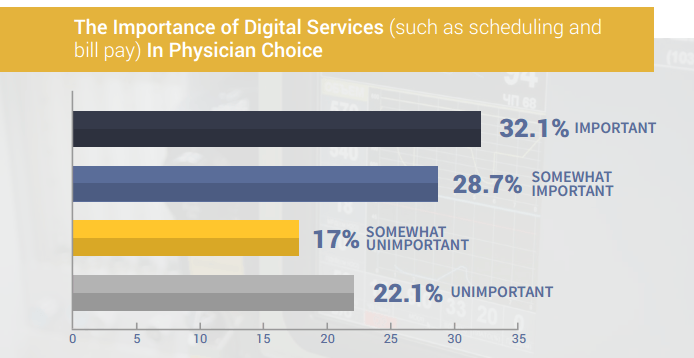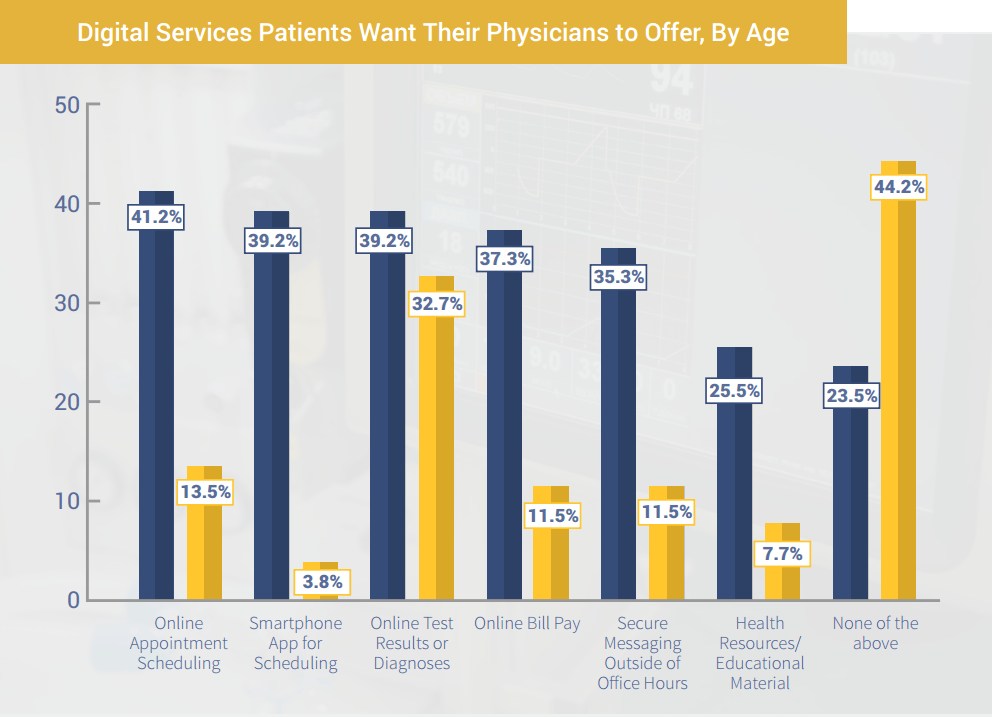New patient engagement trends from TechnologyAdvice Research reveals digital engagement is a growing factor in how patients choose healthcare providers.
Quality of care has long been a primary factor in choosing a healthcare provider, but convenience and communication are also becoming key considerations for patients. Still, many physicians do not appear to be offering the digital engagement services that can meet those demands.
The Importance of Digital Services

According to a new nationwide survey conducted by TechnologyAdvice Research, a majority of patients (60.8 percent) said digital services like online appointment scheduling and online bill pay are either “important” or “somewhat important” when choosing a physician. However, when asked what services their current physician provides, less than one-third of patients indicated they have access to either online bill pay, online appointment scheduling, or the ability to view test results and diagnoses online, which are the top three services that patients report wanting the most.
In addition, 68.6 percent of respondents said it was either “somewhat important” or “very important” that a physician follow up with them, yet only 30 percent of respondents reported receiving a follow-up that wasn’t related to bill pay.
“Primary care physicians are reporting some of the highest rates of EHR adoption to comply with government regulations and to receive incentives from Meaningful Use, but a significantly lower number of patients claim to have access to these patient portal services,” said TechnologyAdvice Managing Editor Cameron Graham, who authored the survey. “The issue here may not be implementation of digital services, but instead a lack of patient awareness. If physicians are offering these in-demand digital services, a more proactive approach to promoting them is needed and could create an advantage in attracting and retaining patients.”
The Growing Role of Patient Age

Patient age also appears to influence what services are expected from physicians. Notably, every digital service listed on the survey was in greater demand among younger respondents. For example, 41.2 percent of patients between the ages of 25-34 said they would like their physician to offer online appointment scheduling, while just 13.5 percent of respondents over 65 said the same. The results also showed that 48.4 percent of the youngest respondents (18-24 year olds) would like to use a smartphone app to schedule online appointments. On the other hand, only 3.8 percent respondents 65 and older said they would like their physician to offer a mobile app.
Physicians Should Tailor Their Patient Engagement Approach
The discrepancies show that physicians should tailor approach to patient engagement. For example, physicians may not need to spend much as much time highlighting the benefits of their practice’s patient portal to older patients and should focus more on traditional methods of communication. However, when seeing younger patients, providers should be ready answer more questions about their digital capabilities and an overview of their services offered.
Key Takeaways
– If providers wish to gain an upper edge in attracting new patients (especially younger ones), and in retaining their existing patients, they should invest in a fully featured patient portal system. For many primary care physicians this should not be difficult. Most comprehensive EHRs include patient portal features, and dedicated patient portal vendors are making strides
in integrating with third-party systems. In particular, prioritizing systems with intuitive online appointment scheduling, online bill pay functionality, and online test results could provide a significant draw for new patients.
– For practices that already have patient portal systems, they should dedicate resources to making sure their patient populations are informed of the existence of such services. They should also consider prominently featuring these services in their advertising and on their websites. When orienting new patients to their practice, providers need to have a plan for walking patients through the initial portal set-up requirements and making sure they understand the features available to them.
-For particularly tech-savvy practices, a dedicated smartphone app could help set them apart, and attract younger individuals.
More information on this survey’s results and methodology can be found here. The full report is also available for download here.
